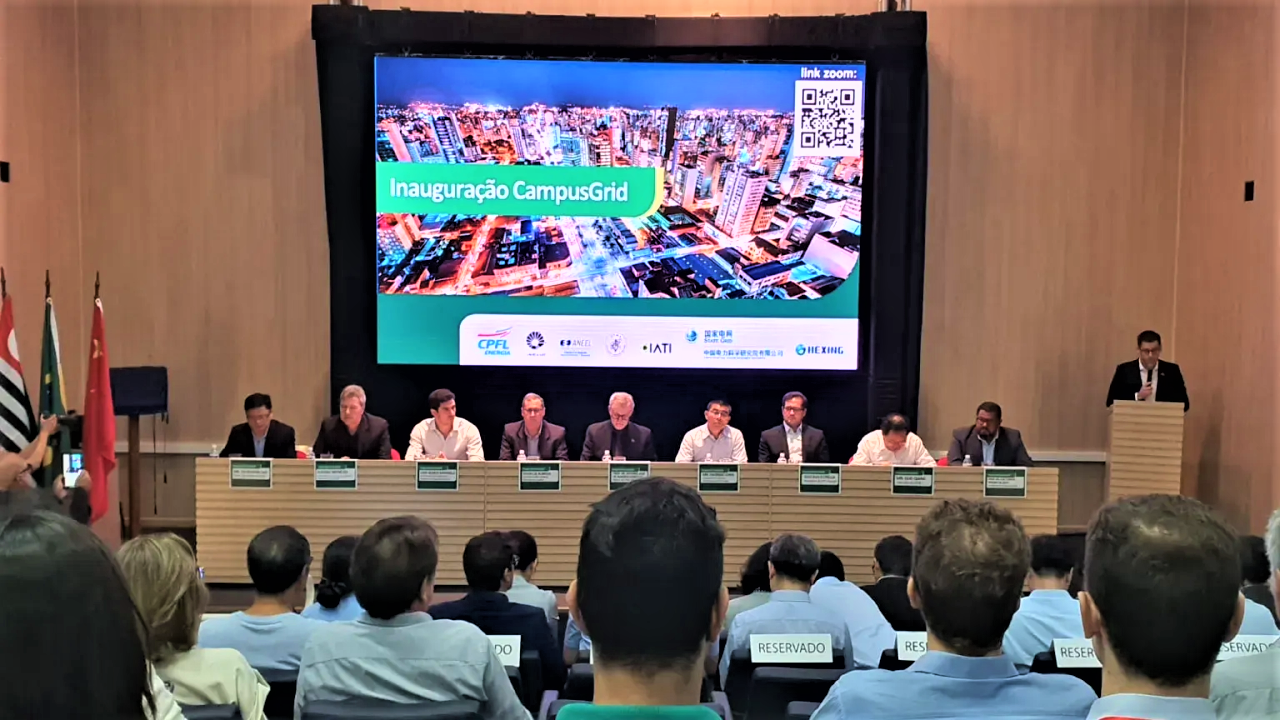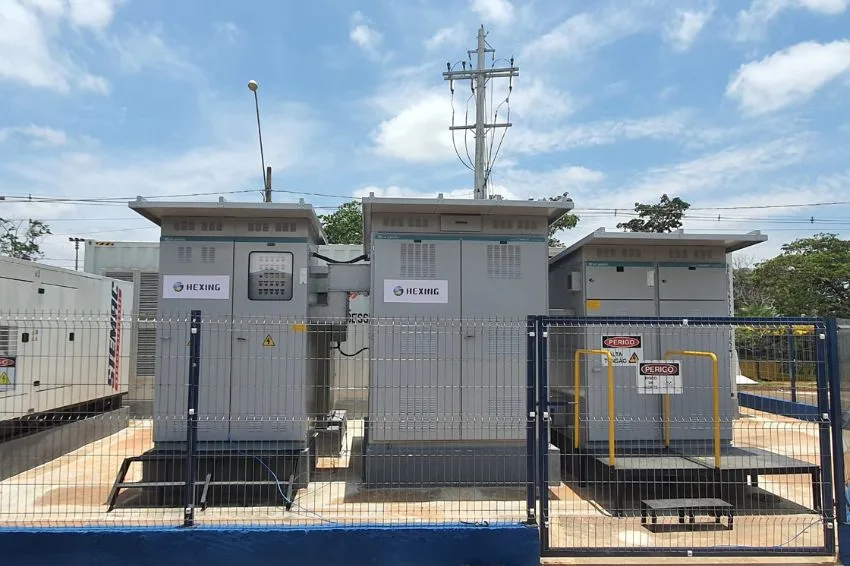2024/12/23
CampusGrid Project to Save R$ 450,000 for the University
On Thursday (Nov 21st, 2024), CPFL Energia inaugurated CampusGrid, a microgrid that integrates various energy generation and storage technologies. Part of a broader R&D initiative by the company, supported by ANEEL (National Electric Energy Agency), this initiative also includes two other microgrids in the city of Campinas (SP), with a total investment of R$ 45.3 million in research and implementation.
The project is part of the MERGE (Microgrids for Efficient, Reliable, and Greener Energy) initiative, involving Unicamp (University of Campinas), UFMA (Federal University of Maranhão), IATI (Advanced Institute of Technology and Innovation), CEPRI (China Electric Power Research Institute), and Hexing Energy Group. It uses the same EMS (Energy Management System) solution as the University of Canton (China), integrating a medium-voltage microgrid with distributed energy sources, including solar, energy storage, and gas generators. Hangzhou Hexing Technology Co., Ltd. is the main EPC contractor, while CEPRI provides technical support.
The project is capable of achieving flexible configuration and control, such as peak reduction, energy arbitrage, voltage and frequency regulation. It also allows for autonomous start-up (black start) of the medium-voltage grid function from the storage system and enables seamless switching between the microgrid and the main grid on the medium-voltage side, both from grid-connected to off-grid and vice versa.

Importance of the Partnership
The partnership with Unicamp strengthens the commitment to technological innovation and the development of energy solutions that can be replicated in various contexts, such as industries, hospitals, and remote communities.
“These pilot projects are essential to expanding the boundaries of innovation in the electricity sector, integrating distributed generation and storage to ensure more efficient, reliable, and sustainable energy supply,” said Gustavo Estrella, President of CPFL Energia Group.
With an annual savings of approximately R$ 450,000 for Unicamp and a significant contribution to CO₂ emission reduction, CampusGrid demonstrates the positive impact of the partnership. “We are committed to developing solutions that benefit both our customers and the environment, preparing the electrical system for future challenges,” Estrella emphasized.
The initiative also strengthens the technological partnership between Brazilian and Chinese institutions, particularly in innovation cooperation and solutions to improve grid reliability and the integration of renewable energy sources and storage solutions.

Microgrid installed at Unicamp.
Differentials of CampusGrid
CampusGrid serves two libraries, a multidisciplinary gymnasium, and the Faculty of Physical Education on campus, integrating a 565 kWp photovoltaic system, a 1 MW/1.27 MWh BESS, and a 250 kVA natural gas generator – all integrated into the EMS system. Designed to operate either connected to CPFL Paulista's grid or autonomously, it ensures energy supply even during interruptions.
Professor Dr. Luiz Carlos Pereira da Silva, from the Faculty of Electrical and Computer Engineering at Unicamp, with expertise in energy efficiency, management, and conservation, highlighted to Canal Solar that this is the largest university microgrid in Latin America and the Caribbean, covering an area of 144,000 m² of the campus.
“The key difference of this project is that the entire area will be immune to blackouts. In the event of an external grid blackout, the microgrid can automatically disconnect from the main grid and operate in island mode autonomously,” he explained.
Additionally, the engineer emphasized that CampusGrid has intelligent panels controlling loads across all buildings and the EMS, which receives all the data and makes decisions on energy dispatch, disconnection from the main grid, reconnection, load shedding, storage, and even cutting photovoltaic generation.
"This system is state-of-the-art in terms of smart grids. You have full monitoring of everything, including a dedicated server to defend against cyberattacks. A microgrid depends on communication and information exchange, making it susceptible to cyber threats. Therefore, we installed a dedicated server to monitor this risk," he added.
Other Microgrids
In addition to CampusGrid, CPFL Energia's project includes two other initiatives. The first, also at Unicamp, is NanoGrid, a microgrid installed at the LabREI (Smart Electric Grid Laboratory), aimed at testing system applications in residential settings.
The second is Congrid, a microgrid located in a residential condominium in the Barão Geraldo district, benefiting 47 homes with solar generation and a battery storage system capable of maintaining power supply throughout the day.
Model for Other Universities
The installation at Unicamp can serve as a model for other universities, as it ensures energy resilience and protects the campus's critical operations from potential risks.
This specific microgrid configuration, comprising photovoltaic systems, battery storage, and backup generation, ensures that universities stay aligned with their sustainability and financial goals—allowing for on-site generation and storage of renewable energy, reducing energy costs and demand, and lowering carbon emissions.
Another key point is the advancement of scientific research that Brazilian universities can conduct. By running experiments using microgrid technology, universities can provide valuable test data and industry standards for the development of microgrids in Brazil, driving continuous improvement and advancement in the technology.
Construction Challenges and EPC
The engineering for the project was provided by Hexing Energy Group, which integrated the design and construction support for the modernization of the electrical infrastructure. The company is responsible for delivering the microgrid and its operation and maintenance for two years.
Hexing, through the Livoltek Power Brasil and Eletra Energy Brasil teams, along with global experts from the Chinese headquarters, effectively coordinated with all relevant stakeholders throughout the initiative, ensuring comprehensive compliance with requirements, including the university's specific research needs.
The project presented significant challenges, mainly due to the complex integration of various connected energy sources, including solar generation, a gasoline generator, and batteries, all from different manufacturers.
This integration required an advanced technical approach to ensure compatibility and optimized performance of each component within the system. Additionally, since it was an installation at medium voltage, highly specialized solutions were required to meet regulatory and technical requirements, as well as ensure operational safety.
In addition to its technical expertise in engineering, Hexing provided the turn-key solution, including the BESS and all services. By leveraging technical knowledge, the company fulfilled its project development responsibilities, ensuring efficient on-site delivery as part of the EPC (Engineering, Procurement, and Construction) process.
Copyright © 2023 HEXING GROUP All rights reserved.